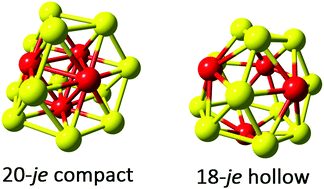Potential to stabilize 16-vertex tetrahedral coinage-metal cluster architectures related to Au20
Abstract
DFT calculations were carried out on a series of tetrahedral 16-atom superatomic clusters having 20 or 18 jellium electrons (je) and structurally related to Au20, namely, [M16]4−/2− (M = Cu, Ag, and Au) and [M4′M12′′]0/2+ (M′ = Zn, Cd, Hg; M′′ = Cu, Ag, Au). While the bare homonuclear 20-je species required further stabilization to be isolated, their 18-je counterparts exhibited better stability. Lowering the electron count led to structural modification from a compact structure (20-je) to a hollow sphere (18-je). Such a change could be potentially controlled by tuning redox properties. Among the 20-je heteronuclear [M4′M12′′] neutral series, [Zn4Au12] appeared to meet the best stability criteria, but their 18-je relatives [M4′M12′′]+, in particular [Zn4Cu12]2+ and [Cd4Au12]2+, offered better opportunities for obtaining stable species. Such species exhibit the smallest models for the M(111) surface of fcc metals, which expose designing rules towards novel high-dopant-ratio clusters as building blocks of nanostructured materials.



 Please wait while we load your content...
Please wait while we load your content...